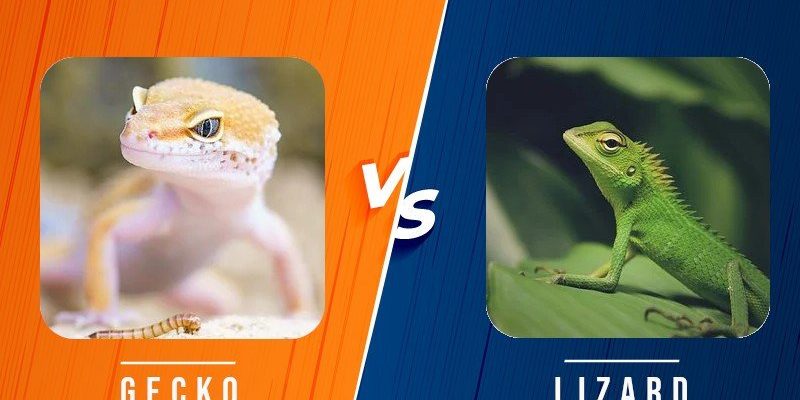![Lizard Vs. [Similar Species] - How They Compare](https://gudri.com/wp-content/uploads/2025/06/Lizard_Vs___Similar_Species____How_They_Compare_image_0.jpg)
Think of it like slicing a pizza into different kinds of toppings. You’ve got your classic pepperoni (lizards) and maybe a Hawaiian (geckos), but the base remains the same. We’ll dig into the juicy details that make each one unique and help you understand what sets them apart. So grab a drink, and let’s dive into the fascinating world of these reptilian relatives!
Basic Differences Between Lizards and Geckos
When you look at lizards and geckos side by side, you might be surprised at how different they really are. Most lizards are more varied in size, shape, and habitat. They can be found in nearly every environment, whether it’s a desert, forest, or even a garden in your backyard. Geckos, on the other hand, are primarily nocturnal and often prefer tropical habitats.
Here’s a fun fact: geckos have unique toe pads that help them climb walls and ceilings. These pads are lined with tiny hairs that create a sticky force, allowing geckos to defy gravity in ways that most lizards can’t. Lizards, while also skilled climbers, don’t have this amazing vocal ability, so geckos often make chirping sounds to communicate, while many lizards remain silent.
Appearance: Size and Color
Lizards come in a wide range of sizes. Some, like the Komodo dragon, are absolutely enormous, while others are so small you might mistake them for a bug! Their skin can vary in color, often featuring patterns that help them blend into their surroundings for protection. This can make catching a glimpse of a lizard in the wild a bit of a challenge.
Geckos, however, tend to be smaller and often have bright, vibrant colors or patterns that can stand out more than lizards. For example, the Leopard gecko has striking yellow and black spots, making it a favorite among reptile enthusiasts. While lizards may sometimes show off dazzling colors, geckos have a flair for the dramatic in their appearance.
Habitat Preferences
Both lizards and geckos have different preferences when it comes to their homes. Lizards are quite adaptable. You can find them basking on a rock in the sun or hiding among leaves. They thrive in various environments, from deserts to forests. Their habitat choice usually depends on their species, with some needing more moisture and others loving the dry heat.
On the other hand, geckos are more often associated with warmer climates. Many gecko species, like the Common house gecko, love to live close to humans, making themselves at home in our houses. They can often be spotted on walls, especially in warm areas, enjoying the warmth from the ambient heat.
Diet and Feeding Habits
When it comes to food, lizards and geckos have some differences worth noting. Most lizards are omnivores, munching on plants, insects, and even small animals. They take what they can get, depending on their environment and what’s available. This adaptability in their diet means they can thrive in various settings, making them quite resourceful.
Geckos tend to stick to a more insect-heavy diet, often feasting on crickets, moths, and other small bugs. Some might even eat fruit or nectar, depending on their species. Their nocturnal feeding habits make them experts at catching prey in the dark, thanks to those sharp senses and quick movements.
Behavior and Temperament
The behavior of lizards can vary widely. Some are quite shy and will hide when they sense danger, while others, like the bold Iguana, might stand their ground. Lizards are also known to bask in the sun, raising their body temperatures to keep active, which is crucial for their survival.
Geckos, while often shy, can be quite social, especially those that thrive in groups. They have interesting interactions with one another, often communicating through clicks and chirps. You might even hear them chattering at night, adding a lively soundtrack to their surroundings. This social aspect can make geckos particularly engaging pets for enthusiasts.
Reproduction and Lifespan
Lizard reproduction varies by species. Some lizards give birth to live young, while others lay eggs. The conditions for their young are essential, and some lizards will guard their eggs until they hatch. This protective behavior is fascinating, showing that they care for their offspring despite how solitary they can be.
Geckos typically lay eggs too, often hiding them in safe spots to protect them from predators. The lifespan of both species can be quite different. Many lizards live around 5-10 years in the wild, but that can extend much longer in captivity. Some geckos have been known to live over 20 years when cared for properly!
Conservation Status
Both lizards and geckos face challenges in the wild. Habitat loss due to urban development and climate change is a significant threat to their populations. Many species are declining, which is concerning for biodiversity. Conservation efforts are essential to help protect their habitats and ensure these remarkable creatures continue to thrive.
You might be wondering why this matters. Well, lizards and geckos play crucial roles in their ecosystems, helping to control insect populations and serving as prey for larger animals. Their presence is often an indicator of a healthy environment!
In the battle of Lizard vs. Gecko, it’s clear that while they share similarities, they each have unique characteristics that make them fascinating in their own right. From their diets to their habitats and behaviors, understanding these differences can deepen your appreciation for these remarkable creatures.
So next time you’re out and about or even enjoying nature from your window, take a moment to spot a lizard or gecko. Observe the little quirks that make them special. They might be small, but they’re a big part of the world around us!

